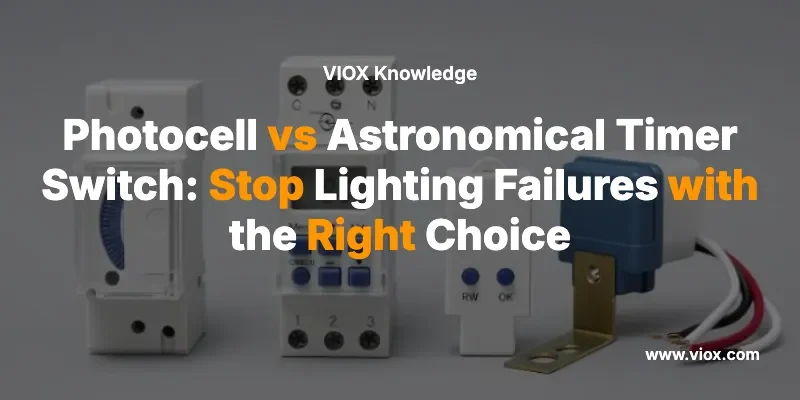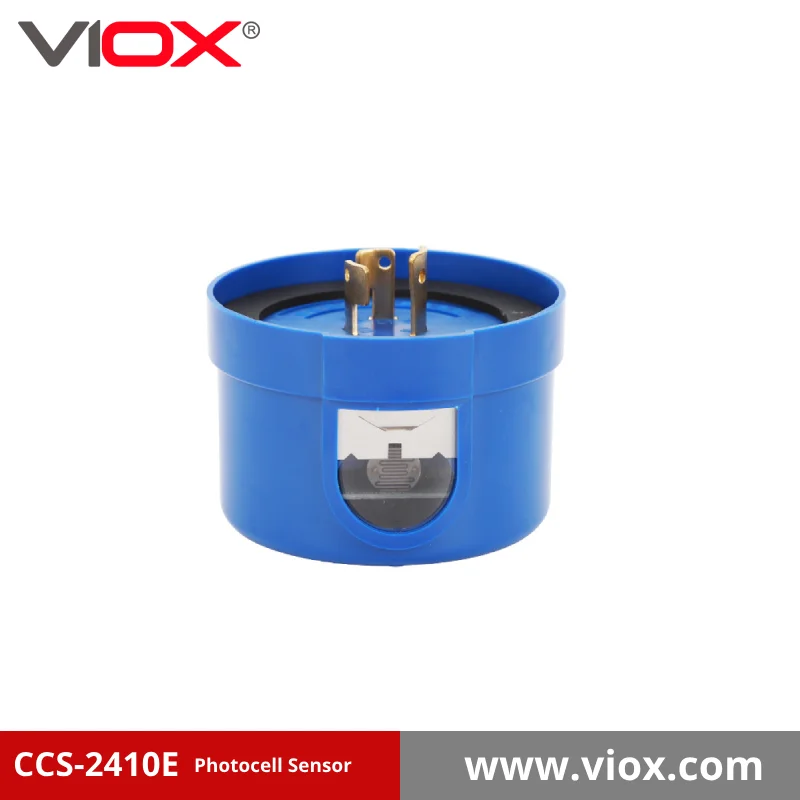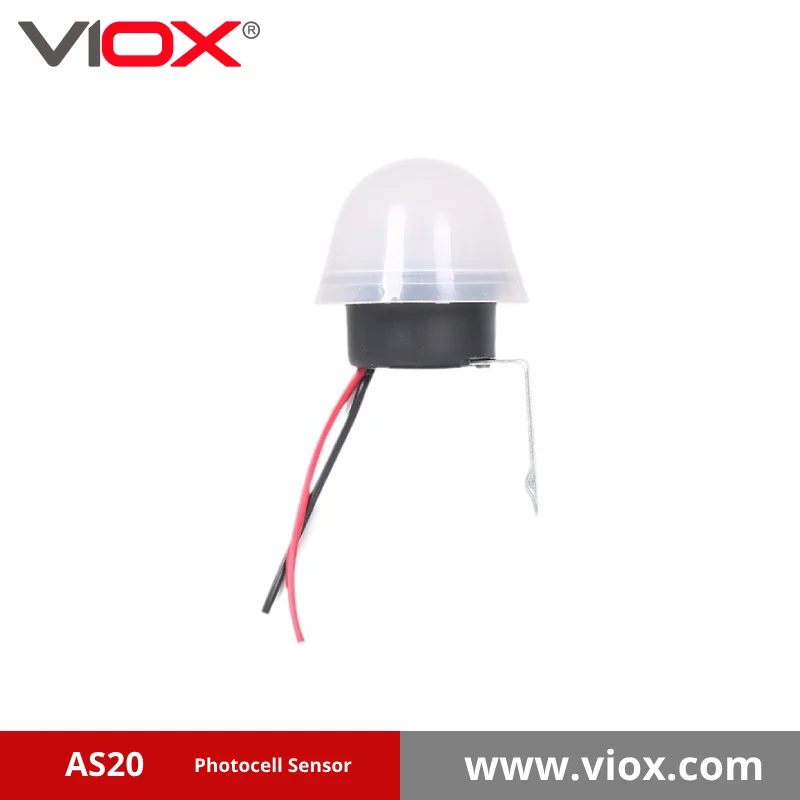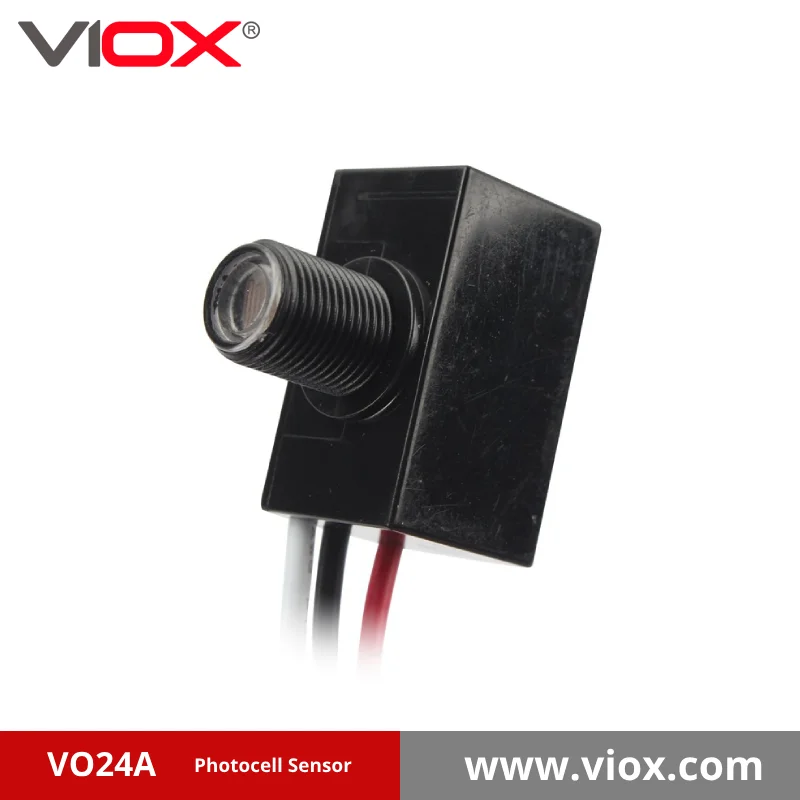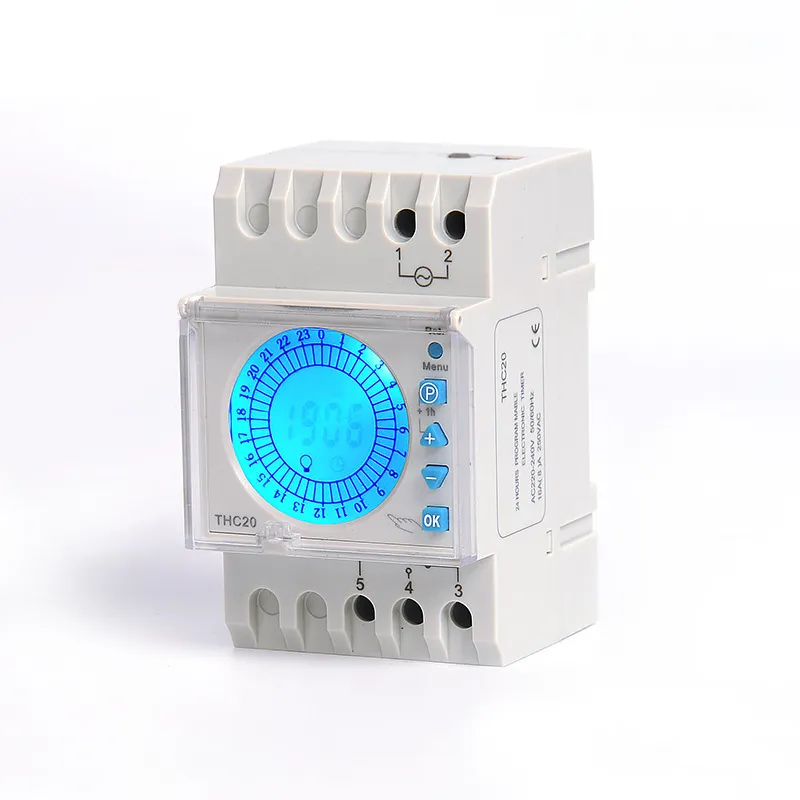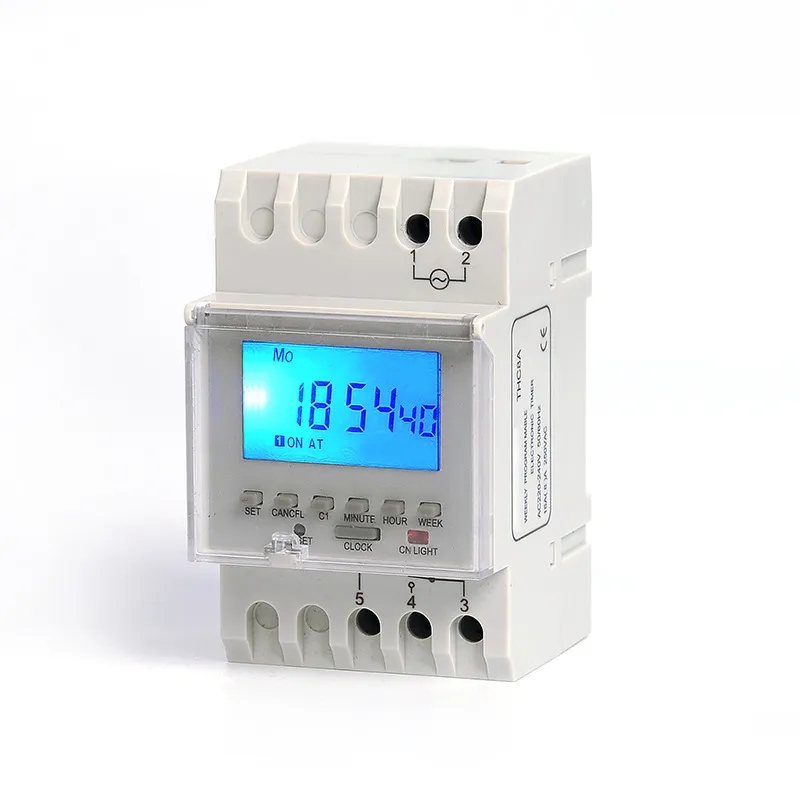You’ve just completed a $50,000 LED security lighting upgrade across your facility. The new fixtures are brilliant. The energy savings projections look great. You installed an automated timer to handle everything—no more manual switches, no more “someone forgot to turn on the lights” emergencies.
Three months later, you get the call at 3 AM.
The entire parking lot is pitch black. There’s been a break-in. Your security team is scrambling. And when you investigate the next morning, you discover the problem: a photocell sensor covered in grime, confused by a new streetlight, has been randomly failing for weeks. The system you trusted to protect your property and people has catastrophically failed.
Here’s the painful question every engineer and facility manager must answer: How do you choose between a photocell timer switch and an astronomical timer switch so your lighting automation never fails when you need it most—while still maximizing energy savings and minimizing maintenance costs?
The answer isn’t about which technology is “better.” It’s about understanding the fundamental difference between reactive sensing සහ calculated precision—then matching the right technology to your specific failure tolerance, installation environment, and operational demands. This guide gives you a proven 4-step selection framework used by lighting engineers to eliminate costly failures before they happen.
Why Outdoor Lighting Automation Projects Fail: The Technology Mismatch Problem
When outdoor lighting automation fails, it’s rarely because the technology itself is broken. The real culprit is a mismatch between the control method and the application’s demands.
Here’s what happens: A facility manager sees “automatic outdoor lighting control” on a product spec sheet and assumes all automation is created equal. They choose based on price alone—usually a basic photocell timer switch because it’s $15 versus $40 for an astronomical model.
But photocell and astronomical timers operate on completely different principles. A photocell is reactive—it responds to real-time ambient light levels, like an automatic eye. An astronomical timer is calculated—it uses your GPS coordinates and calendar date to mathematically determine sunrise and sunset times, then executes a schedule with precision.
This creates opposite failure modes:
- A photocell fails when its environment changes: Light pollution from a new streetlight confuses the sensor. Snow covers it in winter. A spider builds a web across the lens. Dust accumulates over months. Any environmental interference causes unpredictable behavior.
- An astronomical timer fails when real-time conditions don’t match its schedule: A severe afternoon thunderstorm darkens the sky to near-night levels, but the timer won’t activate lights until its programmed time. There’s no emergency override.
යතුරු රැගෙන යාම: The #1 reason lighting automation fails isn’t technology quality—it’s choosing reactive control for applications that demand calculated reliability, or vice versa. Understanding this fundamental difference is your first defense against failure.
The Two Control Philosophies: Eyes vs. Brain
Before you can choose the right timer, you need to understand how each technology actually works. This isn’t just academic—it directly determines where each solution excels and where it fails.
Photocell Timer Switch: The Reactive Sensor
අ photocell timer switch uses a photoresistor—a semiconductor component that changes electrical resistance based on ambient light levels. Think of it as giving your lighting system “eyes.”
How it works:
- As daylight fades at dusk, less light hits the photoresistor
- The resistance increases past a threshold value
- This triggers a relay to close the circuit
- Your connected lights turn ON
- At dawn, the process reverses—rising light lowers resistance, opening the circuit and turning lights OFF
The advantage: Real-time environmental response. If a severe storm darkens the sky at 2 PM, the photocell detects the dangerous low-light condition and activates lights immediately. No programming required—just reactive intelligence.
The fatal weakness: The sensor sees everything. This creates three critical failure modes:
- Light pollution interference: If the photocell can “see” the lights it controls, or nearby streetlights, or car headlights, it gets false readings
- Physical contamination: Dirt, snow, spider webs, leaves, or water droplets on the sensor lens cause malfunction
- Zero scheduling flexibility: Basic photocells only do dusk-to-dawn. You can’t program “lights off at midnight” to save energy
Pro-Tip #1: The #1 reason photocells fail isn’t the technology—it’s wrong placement. If the sensor can ‘see’ any light it controls, you’ve created a feedback loop that causes constant flickering or complete failure. Always mount sensors where they only detect ambient sky light.
Astronomical Timer Switch: The Calculated Scheduler
ඇන් astronomical timer switch contains a microprocessor running precise solar position algorithms. Think of it as giving your lighting system a “brain” that knows exactly when sunrise and sunset occur based on Earth’s rotation.
How it works:
- During initial setup, you input location (city/state or GPS coordinates) and current date/time
- The microprocessor calculates sunrise/sunset times using astronomical formulas
- It updates these calculations daily to account for seasonal changes (sunset happens 1-2 minutes earlier or later each day)
- The timer executes your programmed schedule with precision—typically within ±1 minute of actual astronomical events
- Most models handle Daylight Saving Time automatically
The advantage: Bulletproof reliability in any environment. Because there’s no sensor, light pollution, physical contamination, shadows, or weather cannot affect performance. Plus, you get powerful scheduling—lights on at sunset, off at midnight, back on at 5 AM, then off at sunrise.
The fatal weakness: No real-time awareness. If your area experiences an unusual weather event—like a severe thunderstorm creating near-total darkness at 3 PM—the astronomical timer won’t react. It follows its calculated schedule blindly.
Pro-Tip #2: For security-critical applications, never rely solely on a photocell. A single dirty sensor or light pollution event can leave your property dark all night. Astronomical timers eliminate this single point of environmental failure.
The Engineer’s 4-Step Selection Framework: Matching Technology to Mission
Now that you understand how each technology works, here’s the systematic framework for choosing the right one. This is the same process electrical consultants use when specifying lighting control for commercial and industrial projects.
Step 1: Define Your Mission-Critical Requirements (Failure Tolerance Analysis)
Start by asking one question: What happens if this lighting system fails for one night?
Your answer determines everything:
Security-Critical Applications (Zero Failure Tolerance):
- Building perimeter lighting
- Parking lot and garage lighting
- Loading dock and emergency exit lighting
- Public streetlights and park lighting
- Industrial facility security lighting
For these applications, choose astronomical timers. Why? Because environmental sensor failure is unacceptable. A photocell covered in snow or confused by light pollution creates a single point of failure that could compromise security, safety, and liability.
Aesthetic/Convenience Applications (Moderate Failure Tolerance):
- Residential landscape path lighting
- Garden accent lighting
- Porch and decorative lighting
- Non-security outdoor ambiance
For these applications, photocells work well if you have ideal mounting conditions (Step 2). The lower cost and real-time weather response (lights on during dark storms) provide good value.
Mission-Critical Industrial Applications (Hybrid Approach):
- Chemical plants and refineries
- Distribution warehouses with 24/7 operations
- Critical infrastructure facilities
- Any location where both security AND adaptive safety matter
For these applications, use a hybrid system: Astronomical timer as the primary controller + photocell sensor as a real-time override. This provides scheduled precision AND emergency response to severe weather events.
යතුරු රැගෙන යාම: Your failure tolerance—what happens if lights don’t turn on—is the #1 factor in your decision. High stakes = astronomical. Low stakes with good conditions = photocell.
Step 2: Audit Your Installation Environment (Environmental Risk Assessment)
Even if you’ve decided on a photocell based on Step 1, your installation environment might force you to astronomical anyway. Evaluate these four environmental risk factors:
Risk Factor #1: Light Pollution Exposure
- High Risk: Urban areas with streetlights, building with nearby parking lot lights, locations where controlled lights could reflect back to sensor
- Low Risk: Rural areas, sensors mounted with clear view of northern sky, no nearby artificial light sources
Risk Factor #2: Physical Contamination Potential
- High Risk: Areas with heavy snow, persistent dust/dirt (construction zones, desert climates), dense tree cover (leaves, pollen), high insect activity
- Low Risk: Mild climates, sensors mounted in protected locations with easy access for maintenance
Risk Factor #3: Extreme Weather Conditions
- High Risk: Regions with frequent severe storms, heavy rain, ice accumulation, extreme temperature swings
- Low Risk: Moderate climates with stable weather patterns
Risk Factor #4: Indoor vs. Outdoor Mounting Options
- Restricted: Must mount outdoors where sensor can see sky (forces photocell exposure to elements)
- Flexible: Can mount controller inside electrical room, garage, or weatherproof enclosure (astronomical timer advantage)
Decision Rule: If you scored “High Risk” on 2 or more factors, choose an astronomical timer regardless of Step 1 results. The environmental failure risk of photocells in harsh conditions outweighs any cost savings.
Pro-Tip #3: Installation location flexibility is astronomical timers’ secret weapon. Because they don’t need to “see” the sky, you can mount them inside protected electrical rooms where temperature, moisture, and contamination are controlled. This single factor often justifies the extra cost for commercial installations.
Step 3: Calculate True 5-Year Total Cost of Ownership (TCO)
The price tag at checkout isn’t the real cost. Let’s run the math that lighting engineers use to compare true long-term value.
Upfront Investment:
- Basic Photocell Timer Switch: $15-25
- Quality Photocell with Adjustable Sensitivity: $30-45
- Astronomical Timer Switch (Standard): $40-70
- Astronomical Timer Switch (Advanced Features): $70-120
But here’s where it gets interesting—operational costs over 5 years:
| පිරිවැය සාධකයක් | Photocell Timer | Astronomical Timer |
|---|---|---|
| Initial Purchase | $25 | $60 |
| Replacement (avg. lifespan 3-5 yrs) | +$25 (1 replacement) | $0 (10+ year lifespan) |
| Maintenance Calls (sensor cleaning, troubleshooting) | 2-4 calls @ $75/ea = $150-300 | 0-1 calls @ $75 = $0-75 |
| Energy Waste (dusk-to-dawn only, no midnight shutoff) | ~1,825 hrs/year wasted × 5 years | Schedule optimization possible |
| 5-Year Total | $200-350 | $60-135 |
Now add energy savings from scheduling flexibility:
Assume you control a 150W fixture. If you program an astronomical timer to shut off from midnight to 5 AM (5 hours × 365 days × 5 years = 9,125 hours saved):
- Energy saved: 9,125 hrs × 0.150 kW = 1,369 kWh
- Cost savings at $0.12/kWh: $164
- Cost savings at $0.18/kWh: $246
Net 5-Year Calculation:
- Photocell: $200-350 total cost, $0 energy savings optimization = $200-350 net
- Astronomical: $60-135 total cost, -$164 to -$246 energy savings = -$104 to +$29 net
The astronomical timer pays for itself and often generates positive ROI over 5 years through lower maintenance, longer lifespan, and energy optimization.
යතුරු රැගෙන යාම: The true cost calculation flips the conventional wisdom. Astronomical timers appear expensive upfront but deliver lower total cost of ownership through eliminated maintenance calls, longer service life, and programmable energy savings. For commercial installations controlling multiple fixtures, ROI comes even faster.
Step 4: Apply the Decision Matrix (Final Technology Match)
You’ve now analyzed failure tolerance, environment, and costs. Here’s the final decision matrix that accounts for all factors:
Choose Photocell Timer Switch When:
- Application is aesthetic/convenience (landscape, porch, garden)
- Installation environment scores “Low Risk” on all four environmental factors
- Sensor can be mounted with clear northern sky view away from controlled lights
- You value real-time storm response (lights on during dark daytime weather)
- Initial budget is constrained and you can accept moderate failure risk
- Property has low light pollution and regular maintenance access
Choose Astronomical Timer Switch When:
- Application is security, safety, or compliance-critical
- Installation environment has ANY high-risk factors (snow, dust, urban light pollution)
- You need scheduling flexibility (midnight shutoff, custom programs)
- Controller will be mounted indoors or in weatherproof enclosures
- Long-term TCO and reliability matter more than upfront cost
- You want “set and forget” operation with minimal maintenance
- Facility is at extreme latitudes with unusual twilight periods
Choose Hybrid Approach (Astronomical + Photocell Override) When:
- Application is mission-critical industrial or infrastructure
- You need BOTH scheduled precision AND real-time weather response
- Security/safety failure is unacceptable, but so is inflexibility during emergencies
- Budget allows for premium dual-assurance control system
- You’re operating 24/7 facilities where adaptive lighting affects worker safety
Pro-Tip #4: For industrial and commercial facilities, the hybrid approach delivers the ultimate insurance policy. The astronomical timer handles 99.9% of operation with perfect reliability, while the photocell override activates during the 0.1% of severe weather emergencies when scheduled control isn’t enough. This “dual-assurance” architecture is worth the 30-40% cost premium for mission-critical applications.
Product Recommendations: Proven Solutions for Each Application
After helping hundreds of engineers and facility managers select the right lighting control, these are the specific products we recommend:
For Photocell Applications: VIOX Photocell Switch
When you’ve determined a photocell fits your needs, don’t cheap out. The ALION Photocell Switch includes critical features budget models skip:
- Adjustable sensitivity threshold (prevents false triggering from light pollution)
- Built-in time delay (eliminates flickering from passing car headlights)
- IP65 weatherproof rating (survives harsh outdoor conditions)
- Wide voltage compatibility (120-277V for diverse applications)
- 5-year manufacturer warranty (double the industry standard)
Ideal for: Residential landscape lighting, garden accents, porch lights where installation site has clear sky access and minimal light pollution.
For Astronomical Applications: VIOX AHD16T Astronomical Time Switch
For security, commercial, and industrial applications demanding bulletproof reliability:
- 40-year perpetual calendar (accounts for leap years, seasonal changes)
- GPS-based location database (3,000+ cities pre-programmed)
- 16 programmable ON/OFF events (complex schedules for energy optimization)
- Built-in lithium battery backup (retains programming through 5-year power outages)
- Automatic DST adjustment (eliminates twice-yearly manual corrections)
- අතින් අභිබවා යාමේ හැකියාව (emergency control when needed)
Ideal for: Building perimeter security, parking lots, streetlights, loading docks, any application where failure isn’t an option.
Your Lighting Control Decision: Made Simple
You’ve now completed the same analysis process professional lighting engineers use when specifying outdoor controls for multi-million-dollar projects. Here’s your actionable summary:
If your lighting protects people or property: Choose astronomical. Environmental sensor failure is an unacceptable single point of failure. The precision, reliability, and installation flexibility justify the cost.
If your lighting is aesthetic and your site is ideal: Choose photocell. The real-time weather response and lower cost make sense when failure risk is low and mounting conditions are perfect.
If your facility is mission-critical: Invest in the hybrid approach. The dual-assurance architecture eliminates both scheduled gaps and weather-related failures.
The choice between photocell and astronomical timer switches isn’t about “better” technology. It’s about matching control philosophy—reactive sensing vs. calculated precision—to your specific failure tolerance and installation realities.
Make the wrong choice, and you risk the 3 AM emergency call. Make the right choice using this framework, and your outdoor lighting automation will work flawlessly for the next decade while delivering measurable energy savings and eliminating maintenance headaches.
Ready to specify the right timer for your application? Use the decision matrix in Step 4, calculate your 5-year TCO, and select the technology that matches your mission. Your future self—and your maintenance budget—will thank you.
Frequently Asked Questions: Photocell vs Astronomical Timer Selection
Q: Can I use a photocell timer in an urban area with streetlights?
A: Not recommended. Urban light pollution creates false readings that cause unreliable operation. If the photocell can “see” nearby streetlights, parking lot lights, or building lights, it will trigger incorrectly. For urban installations, astronomical timers eliminate this interference problem entirely.
Q: How long do astronomical timer batteries last, and what happens when they die?
A: Quality astronomical timers like the ALION AHD16T use industrial lithium batteries rated for 5-10 years. When the battery eventually depletes, the timer loses its programming and time reference during power outages but continues normal operation when powered. Simply reprogram the device—most installers take a smartphone photo of the settings screen for easy reference.
Q: Will a photocell turn my lights on during severe daytime storms?
A: Yes, and this is actually a key advantage. If a thunderstorm or unusual weather event creates dangerous low-light conditions at 2 PM, a photocell will detect the darkness and activate lights immediately. An astronomical timer will not—it follows its calculated schedule regardless of real-time conditions. This makes photocells valuable for applications where adaptive weather response improves safety.
Q: Can I program an astronomical timer to turn lights OFF at midnight and back ON at 5 AM?
A: Absolutely. This energy-saving strategy is one of the major advantages of astronomical timers. Most models support 8-16 programmable ON/OFF events per day. For a typical parking lot, you might program: ON at sunset, OFF at 11 PM, ON at 5 AM, OFF at sunrise. This can reduce operating hours by 25-30% annually compared to dusk-to-dawn photocell operation.
Q: Do I need an electrician to install these timers?
A: Both technologies require basic electrical wiring, which means working with line voltage (120V-277V). Most building codes require licensed electricians for this work. The installation is straightforward—both timers replace standard light switches or connect inline with lighting circuits—but electrical safety and code compliance mandate professional installation.
Q: What’s the difference between NEMA 3R and IP65 ratings for outdoor timers?
A: Both ratings indicate weather resistance, but they’re different standards. NEMA 3R (North American standard) protects against rain, sleet, and ice damage. IP65 යනු IP65 හි ඇති බහුමාපකයකි. (international standard) means dust-tight and protected against water jets from any direction. For outdoor installations, look for minimum NEMA 3R or IP65 ratings. Higher ratings (NEMA 4X, IP66/67) provide extra protection in harsh industrial or coastal environments.

